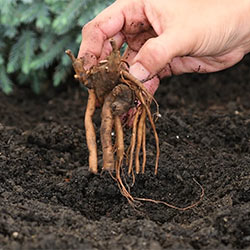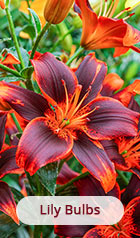
How to Grow Lavender: Lavender Planting Guide
Lavender plants are not only fragrant, they're true garden workhorses. Lavender are easy to care for, and they work well as low hedges, edge plants, and more! Their flowers can be cut and dried to bring the fragrance of lavender indoors, and lavender tea is a summertime favorite. Lavender is a true staple, especially in climates that are prone to drought or high heat.
So, how do you get started with growing lavender? Read on for more tips and tricks about growing this well-loved perennial.
What is Lavender?
Lavender is among the most popular and fragrant
sun plants, with flowers that have been used for essential oils, culinary purposes, and decoration for centuries. Lavender, or Lavandula, is an extensive group of plants known for their lovely purple flowers and fresh, herbal fragrance. Lavender actually belongs to the mint family, and, with its rich fragrance and herbaceous habit, you may see the resemblance.
Lavender grows in a variety of forms, but nearly all lavender varieties feature long stems of blooms and buds. The colors vary, and some
pink lavender and
blue lavender plants shift toward ends of the color spectrum of these purple flowers.
English lavender tends to be more cold-hardy and stay in a more compact form. French lavender has a lighter scent but grows taller than English lavender, and many
hybrid lavenders marry the best features from individual cultivars.
No matter what type of lavender you choose, this vigorously-growing plant will thrive in edges, borders, or containers, and provides major attraction to pollinators.
Planting Lavender
Lavender is easy to care for, and easy to plant. In fact, the hardest part may be choosing a location!
When Should You Plant Lavender?
Lavender plants, when transplanted as bare roots, small plants, or cuttings, are best planted in springtime. Planting in spring gives the roots plenty of time to become established before the harsh winter, and the plants will be more established come fall.
Wait until the spring weather has warmed to about 60 degrees during the day, and until all threat of frost has passed before planting.
Where Does Lavender Grow Best?
Lavender grows best in sunny locations with soil that drains well. Here are a few tips to consider when planting lavender:
- Lavender is the perfect plant for a space that tends a little on the dry side. It prefers dry soil to wet soil.
- Although lavender does require some moisture, too much watering can lead to root rot. Don't site this plant in a patch of heavy, clay soil.
- This herbaceous perennial can also handle poor soil, meaning that it doesn't need rich, fertile soil to thrive-in fact, too-rich soil can stunt lavender plants.
- Lavender plants need at least six hours of sunlight per day for maximum blooming power.
Lavender is a fairly flexible plant, although picky about receiving too much water. It can thrive in planters or pots, and can handle a little afternoon shade. Once you've chosen the right place for your lavender plants, the fun part begins!
How to Plant Lavender
Setting your lavender plants in the ground is an easy task. You'll have your plants off to a successful beginning by following these steps:
- Check your lavender plants to ensure that each plant is healthy, with several roots started from the clump. If the roots are tangled or potbound, gently break them up.
- Plan the spacing of your lavender. Most plants will need to be spaced about two feet apart, but check the planting instructions for your specific variety, and consider the grown height of the mature plants as well as the spread.
- Prepare a planting hole about as deep as the bareroot plant is long from crown to end of roots, and about twice as wide. If you have heavy soil, use loam or peat moss to amend the area. For planting in containers, use well-draining potting soil.
- Set your lavender in the hole with the "crown" of the plant, where the stems meet the roots, level with the ground.
Backfill the hole, watering as you go to help the dirt settle in around the roots.
- Only water in the coming weeks if your region is experiencing very dry weather. Once you've planted your lavender, these plants should come back for several years. Get ready to enjoy them!
Caring for Lavender
Lavender plants are easy to care for-just don't let them become waterlogged. In fact, these are the kinds of plants that will suffer from too much attention, not from a lack of care!
Companion Plants for Lavender
Lavender thrives in harsh conditions, so choose neighbors that share its tenacity. Echinacea, or coneflowers, are another prairie-friendly, drought-hardy plant, or try tall yarrow set behind shorter lavender. Shasta daisies and rudbeckia also make great companions.
Because lavender flowers in summer, it can be a great foil for springtime bulbs. As your bulbs begin to fade, lavender is beginning to turn green and grow. Plant lavender in front of tall tulips and daffodils to hide fading foliage from those sun-loving spring bulbs.
Tips and Tricks for Lavender Care
- Water every couple of weeks for the first season, after the first year lavender is fairly resistant to drought. Lavender planted in containers may need to be watered more frequently.
- Lavender plants should be deadheaded for maximum reblooming. Cut back flower stems after the first bloom of the year to encourage later blooming, and enjoy another round of those spicy-scented flowers.
- After the first few seasons, lavender will need to be pruned at the end of each season to retain its shape. Cut the plants back to about 12" after blooming.
- Don't mulch around lavender plants, as mulch contains too much moisture for these plants to tolerate.
End of Season Care for Lavender Plants
Lavender is fairly easy to take care of between seasons. Some of the best advice for lavender is to leave it be for most of the year. Make sure to clean around the lavender plants, and wait until early fall to prune back.
Avoiding pests
Keep your lavender free of pests and molds by removing debris around the plants at the end of the year. Clear fallen leaves, blown mulch, and any other "garden junk" from around the base of your plants.
Pruning
Don't cut your lavender plants all the way back to the ground during the growing season, as their foliage absorbs sunlight, sending energy to their roots. However, you should prune your lavender plants back after the last flush of flowers has faded, typically in early fall. Shape the plant into a mounded form, if you so choose.
Dividing and Transplanting
Lavender doesn't survive transplanting well. If you would like to thin out your lavender plants, try pruning a bit harder, and closer to the roots, at the end of the season.
Armed with the right information, you'll find lavender is easy to grow and care for, during the growing season and after. Check out more of our
planting guides to learn about other easy-care favorites.
Have another question? Return to the Customer Service Help page or send an e-mail directly to Customer Service






















